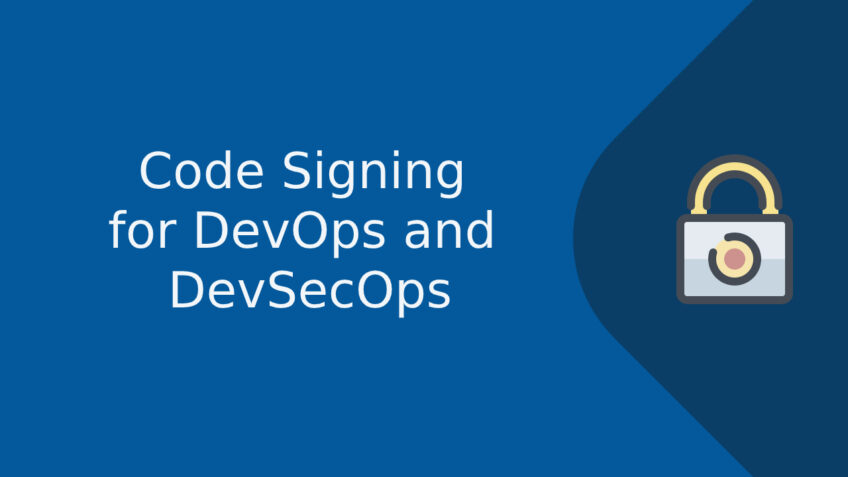Code Signing is a method by which a trusted certificate authority digitally signs you (CA). The CA verifies the identity and end users that their identity has been checked by the author or publisher who submits the program. While this method is very conceptually straightforward, some best practices can be introduced in signing code to make the process a little simpler and more effective.
Note that the problem is not with the process of code signing itself. Code signature is a well-known best practice for safety. However, the way you do it will contribute greatly to the success of your attempts to sign your code. What you need to look at is how your organization secures computer identity when signing your code.
But it’s no easy task to keep them safe.
Security versus speed: Security and Public Key (PKI) teams would rather isolate and lock private signature keys, but emerging businesses need fast signature access and development. Security versus speed.
Dispersed Dev: The production teams today operate in dispersed countries around the world. Code signing keys on developer workstations and build servers are frequently left open to hackers.
No Disruption: In DevOps, the name of the game is periodic incremental apps. Changes to the Lifecycle of Software Development (SDLC) can lead to risk and market delay.
In order to encrypt and authenticate code, digital signatures use public key cryptography technology.
- A developer applies to code or material a digital signature with the single private key of the certificate of signature.
- When a user downloads or meets the signed code a user uses a public key to decrypt the signature
- The device searches for a “root” certificate that confides in or recognizes the signature.
- The framework then compares the hash used by the downloaded application to the hash
- The download and execution continues if the machine trusts root, haze and hazard.
- If the system doesn’t believe in the root or hashes, the system will stop downloading with an alert or the download will fail.
Centralized and automatic code signing and certificate use of cryptographic hardware should be used. Here we go through the hardened code signing process and how its management in DevOps and DevSecOps pipelines is streamlined.
Hardened Code Signing in 4 Steps
The code publisher requires a public-private key pair to securely sign the code. Most architecture, like Windows, Java and others, require this. A FIPS 140-2 Level 3 validated hardware security module is the best way to generate code-signing keys (HSM).
Submit public key and Certificate Signing Request (CSR) with an issuing certificate authority (CA)
- The CSR is generated and submitted to an issuing CA with the main pair generated in phase No. The CSR provides details describing the editor and signing algorithm and the digital signature. The issuing CA uses this information to issue the certificate of signature.
- In some cases, like the manufacture of IoT products, the business may decide to function as its own CA.
Identification of publisher and authentication of CSR
The Issuer CA checks the identity of the code editor and authenticates the CSR by ensuring that the editor signs it numerically. If both identification and authentication succeed, the CA editing bundles the publisher’s identity with the public key and then signatures the package to establish a certificate of code signature.
Ready to sign. Determine the level of security
As a consequence, any executable can be signed and deployed if more code testing or QA is required. The code signing certificate can now be used. In many cases companies, especially fast moving companies, save their code signing keys on the local machine or server of the code publisher, an insecure method which can lead to considerable difficulties. Specific keys are significant safety threats when stored on a local computer or server. The local computer may get compromised/stolen along with code signing keys, or an uneasy employee may maliciously sign and deploy unauthorized code, which may stay unnoticed for a while.
Integration with Code-Signing Technologies
Cryptographic KMS and HSM devices which provide hard key storage commonly integrate with popular code signing technologies that perform various tasks, such as validation of publishing identity and code integrity. For example, Microsoft Authenticode companies using SignTool.exe will integrate directly with a KMS which has complete certificate management. Java Jar Signer, RPM (Red Hat), Docker and a number of IoT implementations also feature other integrations and use scenarios. Furthermore, innovators look at applications which can use advanced code signing workflows beyond normal OS and runtime SDKs to interact closely with CI/CD systems. Furthermore, creative organizations.
Integrating HSM into DevOps and DevSecOps pipelines increases quality of operations at the same time and facilitates additional organisational cryptography operations.
The best thing to import and store is a Key Management Server (KMS) code-signing certificate, which stores the certificate behind a tamper-resistant physical border FIPS 140-2 standard. In order to simplify the entire code signing and certificate management life cycle, a KMS with correct encryption characteristics and functionality can be used in addition to harded storage. A KMS enables DevOps and DevSecOps teams to easily incorporate best practices, eliminate manual bottled workflows and integrate natively with CI/CD systems. Faster code deployment and increase team performance lead to less time creating and administering digital certificates.
Also Read
Types of Code Signing Certificate
Free Code Signing Certificate and How to get it
Code Signing vs SSL Certificate
Benefits of Code Signing Certificate – Why Code Signing is Important?


